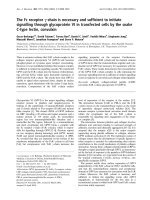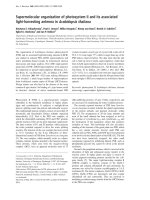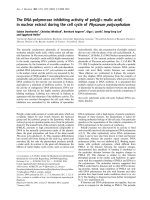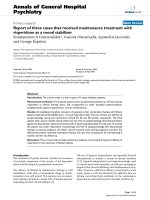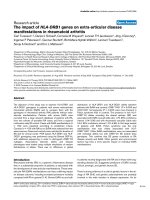Báo cáo y học: "The MHC2TA -168AG gene polymorphism is not associated with rheumatoid arthritis in Austrian patients" pps
Bạn đang xem bản rút gọn của tài liệu. Xem và tải ngay bản đầy đủ của tài liệu tại đây (102.6 KB, 5 trang )
Open Access
Available online />Page 1 of 5
(page number not for citation purposes)
Vol 8 No 4
Research article
The MHC2TA -168A>G gene polymorphism is not associated with
rheumatoid arthritis in Austrian patients
Babak Yazdani-Biuki
1
, Kerstin Brickmann
1
, Klaus Wohlfahrt
1
, Thomas Mueller
1
, Winfried März
2
,
Wilfried Renner
2
, Manuela Gutjahr
2
, Uwe Langsenlehner
3
, Peter Krippl
3
, Thomas C Wascher
4
,
Bernhard Paulweber
5
, Winfried Graninger
1
and Hans-Peter Brezinschek
1
1
Department of Internal Medicine, Division of Rheumatology, Medical University Graz, Austria
2
Clinical Institute of Medical and Laboratory Diagnostics, Medical University Graz, Austria
3
Department of Internal Medicine, Division of Oncology, Medical University Graz, Austria
4
Department of Internal Medicine, Diabetes and Metabolism Clinic, Medical University Graz, Austria
5
Department of Internal Medicine, Landeskrankenanstalten Salzburg, Salzburg, Austria
Corresponding author: Hans-Peter Brezinschek,
Received: 23 Feb 2006 Revisions requested: 6 Apr 2006 Revisions received: 8 May 2006 Accepted: 17 May 2006 Published: 15 Jun 2006
Arthritis Research & Therapy 2006, 8:R97 (doi:10.1186/ar1974)
This article is online at: />© 2006 Yazdani-Biuki et al.; licensee BioMed Central Ltd.
This is an open access article distributed under the terms of the Creative Commons Attribution License ( />),
which permits unrestricted use, distribution, and reproduction in any medium, provided the original work is properly cited.
Abstract
An association between susceptibility to rheumatoid arthritis
(RA) and a common -168A>G polymorphism in the MHC2TA
gene with differential major histocompatibility complex (MHC) II
molecule expression was recently reported in a Swedish
population. The objective of the present study was to replicate
this finding by examining the -168A>G polymorphism in an
Austrian case–control study. Three hundred and sixty-two
unrelated RA cases and 351 sex-matched and age-matched
controls as well as 1,709 Austrian healthy individuals were
genotyped. All participants were from the same ethnic
background. Genotyping was performed using 5' allelic
discrimination assays. The association between susceptibility to
RA and the -168A>G single nucleotide polymorphism was
examined by chi-square test. Comparison was made assuming
a dominant effect (AG + GG genotypes versus AA genotype).
In contrast to the primary report, the frequency of MHC2TA -
168G allele carriers was not significantly different between
patients and controls in the Austrian cohort. The homozygous
MHC2TA -168 GG genotype was more frequent in matched
controls than in Austrian RA patients. There was no association
between the presence of RA-specific autoantibodies and the
MHC2TA -168 GG genotype. In this cohort of Austrian patients,
no association between the MHC2TA polymorphism and RA
was found.
Introduction
Rheumatoid arthritis (RA) is a chronic, progressive, autoim-
mune disease characterized by inflammation of the synovium
and subsequent joint destruction [1]. It is a complex disease,
with genetic and environmental factors contributing to its eti-
ology. The prevalence of RA in Europe ranges from 0.3% to
1.6%, with higher prevalence in the north of Europe [2]. Stud-
ies in twins suggest that the genetic component of RA
accounts for approximately 60% of disease susceptibility [3].
The concept of a strong genetic component to susceptibility
to RA is well established, and the HLA-DRB1 locus is esti-
mated to account for approximately 30% [4]. Several HLA-
DRB1 alleles encoding the 'shared epitope' are recognized as
disease-risk alleles or disease-severity alleles [5-7]. In addi-
tion, a strong association between RA-specific autoantibodies
and PTPN22 has been reported [8,9]. Several genome-wide
linkage studies and numerous association studies involving
positional and/or functional candidate genes have tried to
identify further RA susceptibility loci, with controversial results
in different populations [10,11].
Swanberg and colleagues recently reported an association of
a common -168A>G polymorphism in the MHC2TA gene with
differential major histocompatibility complex (MHC) II mole-
cule expression and susceptibility to diseases with
aCCP = anti-cyclic-citrullinated peptide; CI = confidence intervals; ELISA = enzyme-linked immunosorbent assay; OR = odds ratios; RA = rheumatoid
arthritis.
Arthritis Research & Therapy Vol 8 No 4 Yazdani-Biuki et al.
Page 2 of 5
(page number not for citation purposes)
inflammatory components, such as multiple sclerosis or RA
[12]. Although the results of that study were convincing and
biologically plausible, the need for replication of this associa-
tion has been raised [13].
The aim of this study was therefore to validate and extend the
reported association of the MHC2TA -168A>G polymor-
phism with RA in a group of 373 Austrian Caucasian RA cases
and 373 healthy Austrian Caucasian controls.
Materials and methods
A total of 362 RA patients and 351 healthy controls, all Cau-
casians, were included in the study after informed consent and
approval by the local ethics committee were obtained. All
patients fulfilled the American College of Rheumatology
(ACR) criteria for the diagnosis of RA [14]. As an additional
control group, we analyzed 1,709 healthy Austrian individuals
from the population-based Salzburg Atherosclerosis Preven-
tion Program in Subjects at High Individual Risk screening
study [15,16]. All participants gave their written consent to be
included in the study.
Demographic and genetic data of controls and patients,
including the stage of disease as defined by the radiologic
stage (Steinbroker) [17]), are summarized in Tables 1 and 2.
The MHC2TA genotypes were determined by a TaqMan™
fluorogenic 5'-nuclease assay (Applied Biosystems, Vienna,
Austria) using Applera's Assays-by-Design custom service.
The sequences of the primers and probes were as follows: for-
ward primer, 5'-TCTTCACCAAATTCAGTCCACAGT-3';
reverse primer, 5'-ACCTCTAATTTTACCACACTCCCTTA-3';
A-probe, 5'-VIC-CCCTCCCTACACCTC-NFQ-3'; and G-
probe, 5'-FAM-CTCCCCACACCTC-NFQ-3'.
Commercially available kits were used for the detection of anti-
cyclic-citrullinated peptide (aCCP) (Immunoscan RA; Euro
Diagnostica, Malmö, Sweden) and rheumatoid factor (Auto-
statTMII RF IgM; Hycor Biomedical, Kassel, Germany). The
ELISA was performed according to the manufacturer's
instructions.
Statistical analysis was performed using SPSS for Windows,
release 11.0.1 (SPSS Inc., Chicago, IL, USA). Metric values
were analyzed by Student's t test and are presented as the
mean ± standard deviation. Categorical values were com-
pared by chi-square test. According to methods of the primary
report for the MHC2TA polymorphism [12], comparisons
were made assuming a dominant effect (AG + GG genotypes
versus AA genotype). Odds ratios (OR) and 95% confidence
intervals (CI) were determined by logistic regression analysis.
The criterion for statistical significance was P < 0.05.
Results
MHC2TA genotypes were successfully determined in 362
patients and in 351 controls. Genotype distribution did not
deviate from the Hardy-Weinberg equilibrium in patients or
controls.
In contrast to the primary working hypothesis, the frequencies
of MHC2TA -168 G allele carriers were not significantly differ-
ent between patients and controls (Table 1). The MHC2TA -
168 G allele was not associated with an increased risk for RA
in a recessive model (GG + GA genotypes versus AA geno-
type; OR = 0.93, 95% CI = 0.69–1.25) or a co-dominant
model (GG versus genotype GA versus genotype AA geno-
type; OR = 0.86; 95% CI = 0.69–1.09). The homozygous
MHC2TA -168 GG genotype was more frequent in matched
controls than in patients, and the resulting OR of the GG gen-
otype for RA was 0.58 (95% CI = 0.34–0.99).
Table 1
Demographic and genetic data of Austrian rheumatoid arthritis patients and matched control subjects
Patients (n = 362) Controls (n = 351) P value
Male gender (n (%)) 70 (19.3) 70 (19.9) n.s.
Age (years ± SD) 59 ± 13 59 ± 11 n.s.
Disease duration (years ± SD) 9 ± 5 - -
Erosive disease (%) 76 - -
DMARDs (n ± SD) 6 ± 2 - -
MHC2TA -168 AA genotype (n (%)) 184 (50.8) 172 (49.0) -
MHC2TA -168 AG genotype (n (%)) 155 (42.8) 142 (40.5) 0.90 (AG genotype versus AA genotype)
MHC2TA -168 GG genotype (n (%)) 23 (6.4) 37 (10.5) 0.044 (GG genotype versus AA + AG genotypes)
MHC2TA -168G frequency 0.278 0.308 0.21
DMARDS, disease-modifying antirheumatic drugs; n.s., not significant; SD, standard deviation.
Available online />Page 3 of 5
(page number not for citation purposes)
There was no significant difference in the genotype frequency
between the RA patients and the additional larger control
group (n = 1709) for the dominant effect (AA genotype versus
AG + GG genotypes; P = 0.608, OR = 0.942, 95% CI =
0.751–1.151), as well as for the recessive effect (GG geno-
type versus AG + AA genotypes; P = 0.167, OR = 0.726,
95% CI = 0.462–1.141).
The MHC2TA gene among Austrian RA patients was not sig-
nificantly associated with rheumatoid factor positivity, with an
aCCP antibody titer stage of RA, or with the age at onset of
the disease (Table 2).
In the present study, MHC2TA genotype and allele frequen-
cies of the population differed statistically significantly from
those of the primary report [12] (Table 3). The AA genotype
was significantly less frequent among Austrian patients com-
pared with Swedish patients (Table 3; P = 0.02). The AA gen-
otype frequencies were furthermore lower in Austrian matched
controls and in Austrian additional controls compared with the
respective Swedish populations (P < 0.001).
Interestingly, the GG genotype frequency was significantly
higher in the Austrian controls compared with the Swedish
controls: 10.5% of the Austrian matched controls but only
4.8% of the Swedish matched controls carried the GG geno-
type (P < 0.001). This difference was also confirmed in both
extended control groups (8.5% versus 5.1%, respectively; P <
0.001).
Discussion
In the current study 362 Austrian patients with RA and their
matched controls were genotyped for a single nucleotide pol-
Table 2
MHC2TA -168A>G genotype and clinical characteristics of Austrian rheumatoid arthritis patients
AA genotype AG genotype GG genotype P value
Dominant, AA:AG + GG genotypes Recessive, AA + AG:GG genotypes
Rheumatoid factor (n (%)) 0.23 0.27
Positive 136 107 14
Negative 42 42 8
Anti-cyclic-citrullinated peptide (n (%)) 0.89 0.38
Positive 61 57 7
Negative 32 29 6
Stage (n (%)) 0.15 0.40
137407
>1 138 107 15
Age at onset of rheumatoid arthritis
(years ± SD)
50 ± 16 50 ± 16 52 ± 12 0.90 0.50
SD, standard deviation. Data for rheumatoid factor were available from 349 patients, data for the clinical stage of the disease from 344 patients and
data for the anti-cyclic-citrullinated peptide were available from 192 patients. The stage of disease is defined by the radiologic stage (Steinbroker).
Table 3
MHC2TA genotype and allele frequencies in the Austrian and Swedish study populations
Austrian cohort Swedish cohort [12]
RA patients (n = 362) Matched controls
(n = 351)
Additional controls
(n = 1,709)
RA patients (n = 1262) Matched controls
(n = 704)
Additional controls
(n = 1,599)
MHC2TA -168 AA genotype 184 (50.8)* 172 (49.0)
†
894 (52.3)
‡
728 (57.7) 449 (63.8) 989 (61.9)
MHC2TA -168 AG genotype 155 (42.8) 142 (40.5) 669 (39.1) 451 (35.7) 221 (31.4) 528 (33.0)
MHC2TA -168 GG genotype 23 (6.4) 37 (10.5) 146 (8.5) 83 (6.6) 34 (4.8) 82 (5.1)
MHC2TA -168G allele frequency 0.278 0.308 0.281 0.244 0.205 0.216
The MHC2TA genotype and allele frequencies of the present study population and the primary report by Swanberg and colleagues [12]. Carriers of
a -168G allele were less frequent in the Austrian cohort compared with the Swedish cohort. *Austrian rheumatoid arthritis (RA) patients versus
Swedish RA patients, P = 0.02,
†
Austrian matched controls versus Swedish matched controls, P < 0.001,
‡
Austrian additional controls versus
Swedish additional controls, P < 0.001.
Arthritis Research & Therapy Vol 8 No 4 Yazdani-Biuki et al.
Page 4 of 5
(page number not for citation purposes)
ymorphism in the MHC2TA gene, which was recently reported
to be associated with RA in a Swedish population [12].
The results were surprising. In contrast to the Swedish data
reported by Swanberg and colleagues [12], the present study
found no association between the MHC2TA single nucleotide
polymorphism and the Austrian RA patients. To eliminate a
possible bias in our matched controls we additionally geno-
typed a larger control group, but the genotype frequency was
similar.
The reason for the difference between results of the present
study and those of Swanberg and colleagues is currently
unknown. In the primary report, an OR of 1.29 was observed
for carriage of a MHC2TA -168 G allele. The present study
had a statistical power of 0.40 and 0.77 to detect ORs of 1.29
and 1.5, respectively, for carriage of this allele. We are aware
that this low power is a major limitation of the present study.
Further larger studies are necessary to draw firm conclusions
on the role of the MHC2TA polymorphism for RA.
Although the MHC2TA -168A>G polymorphism has convinc-
ingly been associated with MHC2TA gene expression, it is
unclear whether the polymorphism itself is functional or
whether it is in linkage disequilibrium with one or more causal
genetic variants. If the latter was true, than this linkage disequi-
librium may differ across different ethnic populations. Our
results, which are in clear contrast to those previously pub-
lished, could therefore be due to differences in linkage dise-
quilibrium of the -168A>G polymorphism with the
hypothesized causal variant or due to a different haplotype
structure in the population of the present study. This difference
may be also reflected by the fact that the prevalence of RA is
not uniform across Europe, showing higher prevalences in
Northern Europe compared with Southern European countries
[2].
Interestingly, the frequency of the MHC2TA -168A allele was
higher in controls from Austria compared with controls of the
primary report from Sweden [12]. Different allele frequencies
between Northern Europe and Southern Europe have been
described for a variety of gene polymorphisms [18,19] and
reflect ethnic differences across Europe. Similar to our report,
a recent publication by Akkad and colleagues was unable to
replicate the described association between RA and the
MHC2TA allotype in a German population [20]. The frequency
of the MHC2TA G allele in that study was 0.27, which is com-
parable with the frequency of 0.29 among combined controls
of the present study. Further studies analyzing additional poly-
morphisms in the MHC2TA gene might help to elucidate the
role of this gene for RA.
The lack of correlation between the presence of the specific
RA autoantibodies aCCP or rheumatoid factor with MHC2TA
alleles in our cohort is a further indication that the MHC2TA
genotype might not be directly associated with RA. A strong
association between RA-specific autoantibodies and certain
single nucleotide polymorphisms has recently been reported,
especially between PTPN22 and rheumatoid factor and aCCP
[8,9]. Patients with the RA-specific allele PTPN22 were there-
fore significantly more often positive for rheumatoid factor or
aCCP compared with controls [8]. Moreover, all patients who
had the combination of aCCP and PTPN22 T polymorphism
developed RA [9].
Conclusion
We did not find any association of the MHC2TA -168G>A
polymorphism with RA or RA-specific autoantibodies in an
Austrian population. Further independent studies in other eth-
nic cohorts are necessary to delineate whether the differences
between our results and those obtained from the Swedish
population are due to ethnic bias or because of the small sam-
ple size.
Competing interests
The authors declare that they have no competing interests.
Authors' contributions
BY-B and PK conceived of the study, and participated in its
design and coordination and the acquisition of data. WR, WM,
TCW, BP and MG carried out the molecular genetic study.
WR and UL performed the statistical analysis. WG and TM
participated in coordination and interpretation of the data. KB
and KW participated in the acquisition of data and helped
draft and revise the manuscript. H-PB was involved in drafting
and revising the manuscript for important intellectual content
and provided final approval of the version to be published. All
authors read and approved the final manuscript.
Acknowledgements
The authors thank Dr Peter Lipsky for critical review of the manuscript.
This work as supported in part by a grant of the Austrian Society for
Research and Treatment of Immunological and Rheumatological
Diseases.
References
1. Arend WP: The pathophysiology and treatment of rheumatoid
arthritis. Arthritis Rheum 1997, 40:595-597.
2. Guillemin F, Saraux A, Guggenbuhl P, Roux CH, Fardellone P, Le
Bihan E, Cantagrel A, Chary-Valckenaere I, Euller-Ziegler L, Flipo
RM, et al.: Prevalence of rheumatoid arthritis in France: 2001.
Ann Rheum Dis 2005, 64:1427-1430.
3. MacGregor AJ, Bamber S, Silman AJ: A comparison of the per-
formance of different methods of disease classification for
rheumatoid arthritis. Results of an analysis from a nationwide
twin study. J Rheumatol 1994, 21:1420-1426.
4. Deighton CM, Walker DJ, Griffiths ID, Roberts DF: The contribu-
tion of HLA to rheumatoid arthritis. Clin Genet 1989,
36:178-182.
5. Wordsworth BP, Lanchbury JS, Sakkas LI, Welsh KI, Panayi GS,
Bell JI: HLA-DR4 subtype frequencies in rheumatoid arthritis
indicate that DRB1 is the major susceptibility locus within the
HLA class II region. Proc Natl Acad Sci USA 1989,
86:10049-10053.
6. Weyand CM, Hicok KC, Conn DL, Goronzy JJ: The influence of
HLA-DRB1 genes on disease severity in rheumatoid arthritis.
Ann Intern Med 1992, 117:801-806.
Available online />Page 5 of 5
(page number not for citation purposes)
7. MacGregor AJ, Bamber S, Carthy D, Vencovsky J, Mageed RA,
Ollier WE, Silman AJ: Heterogeneity of disease phenotype in
monozygotic twins concordant for rheumatoid arthritis. Br J
Rheumatol 1995, 34:215-220.
8. Plenge RM, Padyukov L, Remmers EF, Purcell S, Lee AT, Karlson
EW, Wolfe F, Kastner DL, Alfredsson L, Altshuler D, et al.: Repli-
cation of putative candidate-gene associations with rheuma-
toid arthritis in >4,000 samples from North America and
Sweden: association of susceptibility with PTPN22, CTLA4,
and PADI4. Am J Hum Genet 2005, 77:1044-1060.
9. Johansson M, Arlestig L, Hallmans G, Rantapaa-Dahlqvist S:
PTPN22 polymorphism and anti-cyclic citrullinated peptide
antibodies in combination strongly predicts future onset of
rheumatoid arthritis and has a specificity of 100% for the
disease. Arthritis Res Ther 2006, 8:R19.
10. Barton A, Ollier W: Genetic approaches to the investigation of
rheumatoid arthritis. Curr Opin Rheumatol 2002, 14:260-269.
11. Barton A, Eyre S, Bowes J, Ho P, John S, Worthington J: Investi-
gation of the SLC22A4 gene (associated with rheumatoid
arthritis in a Japanese population) in a United Kingdom popu-
lation of rheumatoid arthritis patients. Arthritis Rheum 2005,
52:752-758.
12. Swanberg M, Lidman O, Padyukov L, Eriksson P, Akesson E, Jag-
odic M, Lobell A, Khademi M, Borjesson O, Lindgren CM, et al.:
MHC2TA is associated with differential MHC molecule expres-
sion and susceptibility to rheumatoid arthritis, multiple sclero-
sis and myocardial infarction. Nat Genet 2005, 37:486-494.
13. Friese MA, Jones EY, Fugger L: MHC II molecules in inflamma-
tory diseases: interplay of qualities and quantities. Trends
Immunol 2005, 26:559-561.
14. Arnett FC, Edworthy SM, Bloch DA, McShane DJ, Fries JF, Cooper
NS, Healey LA, Kaplan SR, Liang MH, Luthra HS, et al.: The Amer-
ican Rheumatism Association 1987 revised criteria for the
classification of rheumatoid arthritis. Arthritis Rheum 1988,
31:315-324.
15. Strohmer B, Pichler M, Iglseder B, Paulweber B: Relationship of
QT interval duration with carotid intima media thickness in a
clinically healthy population undergoing cardiovascular risk
screening. J Intern Med 2005, 257:238-246.
16. Iglseder B, Mackevics V, Stadlmayer A, Tasch G, Ladurner G,
Paulweber B: Plasma adiponectin levels and sonographic phe-
notypes of subclinical carotid artery atherosclerosis: data from
the SAPHIR Study. Stroke 2005, 36:2577-2582.
17. Steinbrocker O, Traeger CH, Batterman RC: Therapeutic criteria
in rheumatoid arthritis. JAMA 1949, 140:659-662.
18. Enattah NS, Sahi T, Savilahti E, Terwilliger JD, Peltonen L, Jarvela
I: Identification of a variant associated with adult-type
hypolactasia. Nat Genet 2002, 30:233-237.
19. Rosendaal FR, Doggen CJ, Zivelin A, Arruda VR, Aiach M, Siscov-
ick DS, Hillarp A, Watzke HH, Bernardi F, Cumming AM, et al.:
Geographic distribution of the 20210 G to A
prothrombinvariant. Thromb Haemost 1998, 79:706-708.
20. Akkad DA, Jagiello P, Szyld P, Goedde R, Wieczorek S, Gross WL,
Epplen JT: Promoter polymorphism rs3087456 in the MHC
class II transactivator gene is not associated with susceptibil-
ity for selected autoimmune diseases in German patient
groups. Int J Immunogenet 2006, 33:59-61.
